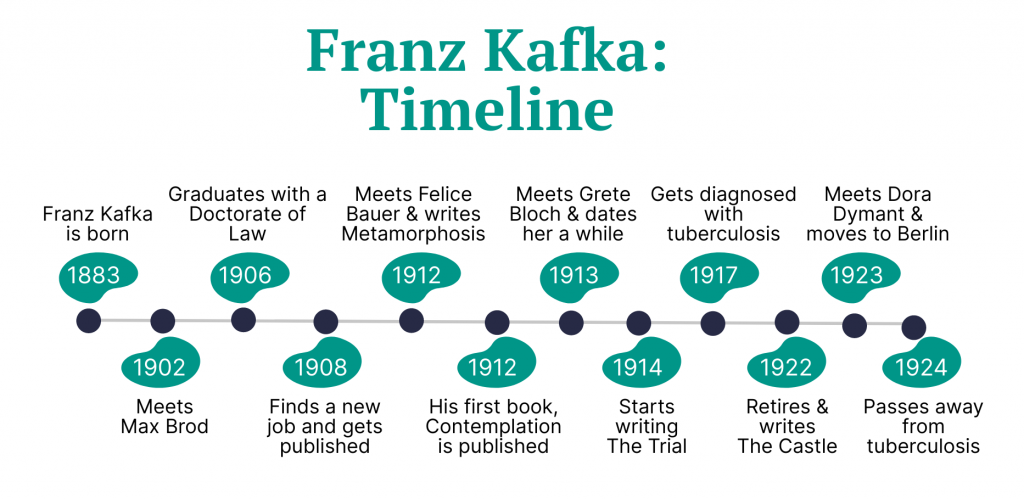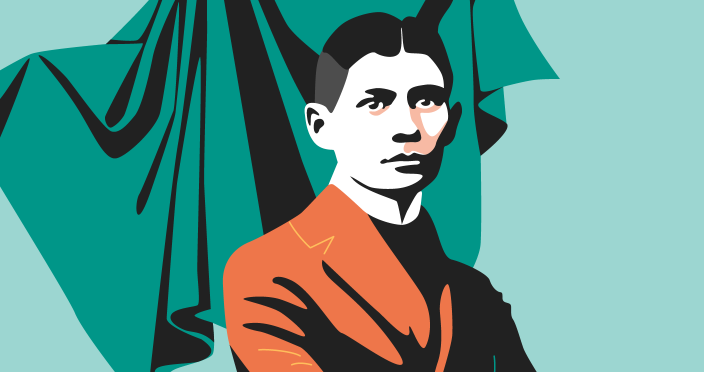Franz Kafka is a famous writer of the early XXth century. He is a widely recognized novelist, most famous for his writing style and the topics on existentialism he discussed. His works are acknowledged as a valuable retrospective on the anxieties of people during his time.
In the article, our writers explored his biography and writing style.
⏱️ Franz Kafka: Timeline
Kafka lived and worked from the end of XIXth to the beginning of the XXth century, a turbulent time for Europe. It saw the rise of new deadly weapons, ideologies, nationalist movements, etc. Most importantly, the Continent witnessed The First World War, which ended many Empires of that time. Kafka’s writing style illustrates his emotions, as its absurdity and surrealism correlate with the anxieties of Europeans during that uncertain period.

👨💼 Franz Kafka’s Biography
Franz Kafka was born on July 3, 1883, to a Jewish German-speaking family in Prague, Austria-Hungary. His parents, Hermann and Julie Kafka, belonged to the upper-middle class of Prague’s population. Hermann had a successful job in a retail store, while Julie was his assistant.
From his early childhood, Franz became alienated from kids of his age. He was a German-speaker in a Czech city while being disconnected from Germans due to his Jewish heritage. Moreover, because of his Germanization and lack of religiousness, he was also an outsider to the Jewish community of his city.
Franz’s character was also heavily influenced by his family and Hermann, in particular. His two younger brothers died in infancy, so he was the only boy in the family, living with his three younger sisters. Kafka could not establish a good emotional relationship with his father, as the latter one was a hot-tempered man who imposed a lot of authority on the family. Franz Kafka’s calm personality and his slim figure could not stand up to Hermann.
Thus, Kafka’s personal rebellion and self-hatred increased over the years. He became fascinated with literature and writing, taking much interest in it. His father was heavily opposed to that, as he wanted his son to pursue a career in business and law. Which Kafka begrudgingly obliged.
Kafka attended the Charles-Ferdinand University of Prague, the oldest and one of the most prestigious universities in the modern-day Czech Republic. He picked chemistry but soon switched to law studies which appeased his father. He was able to take a few literature courses and join a literary club. In 1902 Kafka met with Max Brod. They soon became dear friends for the rest of Kafka’s short life.
After graduating from the University in 1906 with a Doctorate of Law, Kafka was hired as a clerk in an insurance company. He was unhappy with the job, as it was hard to combine his passion for writing with the long working hours at the office. Consequently, he spent many sleepless nights writing his stories.
Kafka did not have many personal relationships, as he lived with his parents and sisters and suffered from anxiety and depression. He felt a lot of pressure from his family, who expected him to become “the man of the house.” In particular, his authoritative father always pushed him to pursue a business career, not trying to understand his son’s passion for writing.
Kafka never managed to develop a healthy connection with his father. This abusive relationship could be found in The Metamorphosis (1912), where the main character Gregor Samsa also suffers from his father’s attitude. Later, in 1919 Kafka wrote the Letter to His Father, contemplating many aspects of their relationship.
However, he was lucky enough to become close friends with Max Brod and Felix Weltsch, fellow Jewish writers, with whom he met many times to discuss literature. Both writers admired Kafka’s stories and style. Max Brod, in particular, would play a critical role after Kafka’s death by publishing his novels for the world of literature.
Franz Kafka had some affairs with women, which contributed to his literary work. In 1912 he met Felice Bauer. He got engaged twice with her, but every time Kafka broke off the engagement. During that time, he wrote The Metamorphosis and other stories.He traveled to Venice in 1913, where he met Grete Bloch. They had a brief relationship there. Shortly after, he began writing The Trial (1914), which he, unfortunately, did not finish.
⚰️ Franz Kafka’s Death
After coming back to Prague, Kafka spent a few years working and renting apartments to get away from his family. In 1917 he got diagnosed with tuberculosis, a deadly disease even today. He had to take a break from his work and focus on healing. Kafka got acquainted with Milena Jesenska around that time, but their relationship ended in two years.
He spent quite a lot of time in sanatoriums and had to completely retire from his job. It was then when he wrote The Castle (1922).
In 1923 Kafka met a Jewish socialist, Dora Dymant, while traveling in the Baltics. The couple moved to Berlin, where they dreamed of going to Palestine to start a new life. However, Kafka’s health worsened, and on June 3, 1924, he passed away from tuberculosis.
🖊️ Franz Kafka’s Works and Writing Style
Most of Franz Kafka’s books were unknown during his life. He published Depiction of a Struggle in 1912 and Meditation in 1913 consequently. He hesitantly published The Judgement (1913), The Metamorphosis (1915), In the Penal Colony (1919), and A Country Doctor (1919).
Max Brod admired Kafka’s works and always pushed him to publish them. After Kafka’s death, Brod decided to ignore his friend’s last wish to destroy the remaining works. Brod published A Hunger Artist shortly after Kafka’s death; The Trial (1925), The Castle (1926), and Amerika (1927) were published respectively.
Kafka gained fame and recognition posthumously. His works are still admired and deeply analyzed by many critics. The style in which he wrote became known as “Kafkaesque.” Often, Kafka describes surreal and grotesque things in his works, expressing his personal anxieties and fears. This creates a ludicrous situation in a real-life setting. For example, in “The Metamorphosis,” Franz Kafka tells a story about Gregor Samsa, who turned into a monstrous insect-like creature. Gregor struggles with his family because of his transformation.
Thank you for reading! We hope it was informative and helpful for your research. Check out other articles about Franz Kafka and his works.
